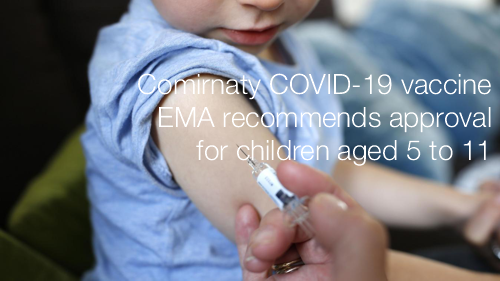Comirnaty COVID-19 vaccine: EMA recommends approval for children aged 5 to 11
Comirnaty COVID-19 vaccine: EMA recommends approval for children aged 5 to 11
News 25/11/2021
EMA’s human medicines committee (CHMP) has recommended granting an extension of indication for the COVID-19 vaccine Comirnaty to include use in children aged 5 to 11. The vaccine, developed by BioNTech and Pfizer, is already approved for use in adults and children aged 12 and above.
In children from 5 to 11 years of age, the dose of Comirnaty will be lower than that used in people aged 12 and above (10 µg compared with 30 µg). As in the older age group, it is given as two injections in the muscles of the upper arm, three weeks apart.
A main study in children aged 5 to 11 showed that the immune response to Comirnaty given at a lower dose (10 µg) in this age group was comparable to that seen with the higher dose (30 µg) in 16- to 25-year-olds (as measured by the level of antibodies against SARS-CoV-2). The efficacy of Comirnaty was calculated in almost 2,000 children from 5 to 11 years of age who had no sign of previous infection. These children received either the vaccine or a placebo (a dummy injection). Of the 1,305 children receiving the vaccine, three developed COVID-19 compared with 16 out of the 663 children who received placebo. This means that, in this study, the vaccine was 90.7% effective at preventing symptomatic COVID-19 (although the true rate could be between 67.7% and 98.3%).
The most common side effects in children aged 5 to 11 are similar to those in people aged 12 and above. They include pain at the injection site, tiredness, headache, redness and swelling at the site of injection, muscle pain and chills. These effects are usually mild or moderate and improve within a few days of vaccination.
The CHMP therefore concluded that the benefits of Comirnaty in children aged 5 to 11 outweigh the risks, particularly in those with conditions that increase the risk of severe COVID-19.
The safety and efficacy of the vaccine in both children and adults will continue to be monitored closely as it is used in vaccination campaigns in EU Member States through the EU pharmacovigilance system and ongoing and additional studies conducted by the company and by European authorities.
The CHMP will now send its recommendation to the European Commission, which will issue a final decision.
How Comirnaty works
Comirnaty works by preparing the body to defend itself against COVID-19. It contains a molecule called messenger RNA (mRNA) which has instructions for making the spike protein. This is a protein on the surface of the SARS-CoV-2 virus which the virus needs to enter the body’s cells.
When a person is given the vaccine, some of their cells will read the mRNA instructions and temporarily produce the spike protein. The person’s immune system will then recognise this protein as foreign and produce antibodies and activate T cells (white blood cells) to attack it.
If, later on, the person comes into contact with the SARS-CoV-2 virus, their immune system will recognise it and be ready to defend the body against it.
The mRNA from the vaccine does not stay in the body but is broken down shortly after vaccination.
Where to find more information
The product information approved by the CHMP for Comirnaty contains prescribing information for healthcare professionals, a package leaflet for members of the public and details of conditions of the vaccine’s authorisation.
An assessment report, with details of EMA’s evaluation of use of Comirnaty in young children, will be published on the EMA website.
The studies in children were carried out in accordance with Comirnaty’s paediatric investigation plan (PIP), which was agreed by EMA's Paediatric Committee (PDCO). Clinical trial data submitted by the company in the application for the paediatric extension of indication will be published on the Agency’s clinical data website in due course.
More information is available in an overview of the vaccine in lay language, including a description of the vaccine’s benefits and risks and why EMA recommended its authorisation in the EU.
Monitoring the safety of Comirnaty
In line with the EU’s safety monitoring plan for COVID-19 vaccines, Comirnaty is closely monitored and subject to several activities that apply specifically to COVID-19 vaccines. Although large numbers of people have already received COVID-19 vaccines, certain side effects may still emerge as more and more people receive the vaccine.
BioNTech, the company that markets this vaccine in the EU, is required to provide regular updates and conduct studies to monitor the safety and effectiveness of the vaccine as it is used by the public. Authorities also conduct additional studies to monitor the vaccine.
These measures allow regulators to swiftly assess data emerging from a range of different sources and take appropriate regulatory action to protect public health if needed.
...
Fonte: EMA
Collegati
































